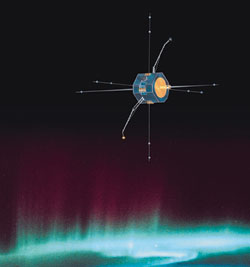
Source: NASA
The Fast Auroral Snapshot (FAST) satellite was part of the NASA Small Explorers (SMEX) Program. It was launched on August 21, 1996 by a winged Pegasus XL rocket released from an L-1011 jet aircraft at an a altitude of about 12,200 meters (40,000 feet) traveling at Mach 0.8. The FAST satellite was inserted into a polar orbit with an altitude range of 350 to 4200 km (220 to 2,600 miles) above Earth. FAST carried instruments to measure energetic electrons and ions, electric fields, and magnetic fields above the Earth’s auroral zones. A Transportable Orbital Tracking Station (TOTS) maintained by NASA was placed at Poker Flat, Alaska to collect real-time data while the spacecraft passed through the northern polar regions. Data is also collected by the European Space Agency (ESA) using a tracking station in Kiruna, Sweden.
University of Minnesota FAST Publications
- Cattell, C., et al., The association of electrostatic ion cyclotron waves, ion and electron beams and field-aligned current: FAST observations of an auroral zone crossing near midnight, Geophys. Res. Lett., in press 1998.
- Sigsbee, K., et al., FAST – Geotail correlative studies of magnetosphere – ionosphere coupling in the nightside magnetosphere, Geophys. Res. Lett., 25, 1998.
Conference Presentations on FAST Research
- FAST Observations of Field-Aligned Currents and Electric Fields During the January 1997 CME Event – C. A. Cattell et al.
- FAST/Geotail Observations of Magnetosphere-Ionosphere Coupling – C. A. Cattell, et al.
- FAST Observations of Upflowing Ion Beams, Field-Aligned Currents and Electrostatic Ion Cyclotron Waves – C. A. Cattell, et al.
- FAST-Geotail Correlative Studies of Magnetosphere-Ionosphere Coupling in the Nightside Magnetosphere – K. Sigsbee, et al.
Data
FAST data at Berkeley
Links
